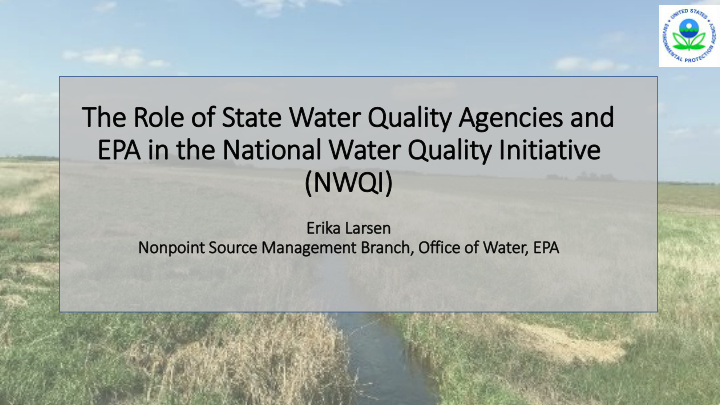



The Role of f State Water Quality Agencies and EPA in in the National Water Quality In Init itiative (NWQI) (N Erik rika Lar Larsen Nonpoin int Source Man anagement Bran anch, Office of of Water, EPA 1
Role of EPA, , NRCS, State Water Quality Agencies NRCS EPA State Water Quality Agency • Targeted water quality • Promote coordination between • Focused water quality conservation practice NRCS and state water quality monitoring in ~60 watersheds • Coordinate with NRCS on implementation and technical agencies • Guidance on NWQI instream assistance through EQIP watershed selection process • NWQI watershed selection • Direct use of 319 funds to monitoring efforts • Assessment and planning • Support state use of 319 funds support variety of activities • Technical support on • Annually report to EPA on through NWQI readiness phase and Source monitoring and watershed NWQI progress water/Drinking water pilot planning • Report on NRCS metrics • Report on state metrics annually annually 2
NWQI is Structured for Water Quality Results • Keys to NWQI success • Targeted implementation of key practices in the right places (critical areas) • Watershed plan in place including producer outreach • Focused partnership efforts in small watersheds • Sharing appropriate data to assess progress through instream monitoring • Principles that increase likelihood of measured WQ improvement* • Adequately describe problems and pollution sources • Critical areas and appropriate conservation practices defined • Watershed plan developed and implemented with local stakeholders • Quantitative water quality and monitoring goals • High level of implementation and producer participation, with good outreach capacity • Have stable funding and effective information, education, technology transfer mechanisms * Per USDA CEAP, Land-grant University, and EPA studies 3
NWQI Water Quality Monitoring • Monitoring Goal: assess NWQI implementation impacts on water quality for nutrients, sediment, and/or pathogens • NPS effectiveness monitoring is challenging, can take 7- 10+ years • NWQI state reporting (2016), preliminary results indicate: • States use a variety of monitoring approaches • Water quality changes for one or more NWQI pollutants have been detected in ~a quarter of NWQI monitoring watersheds, and in nearly all of those watersheds, states indicated that agricultural conservation practices are contributing to those changes . 4
Lessons le learned from ~6 years of NWQI Im Imple lementation • Understand the importance of your role in the NWQI • NRCS, State agencies, and conservation districts have a shared goals and distinct roles • Enhanced NWQI planning: coordinate early on watershed plans, critical source areas, outreach strategies • Keep lines of communication open throughout the year and engage local partners • Need for watershed plans at the right scale • Longer term funding an opportunity to plan ahead for NWQI watersheds, explore broadening the approach • Communicate about challenges, needs, and successes 5
Questions/Discussion Erika Larsen, Larsen.Erika@epa.gov 202-566-0048
Recommend
More recommend